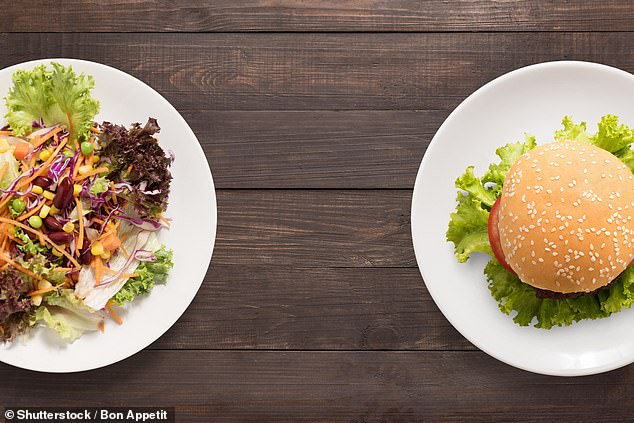People are more likely to choose less wholesome food for lunch if their co-workers make unhealthy choices as well, a study has found.
Researchers from the US analysed the social networks of some 6,000 employees at Massachusetts General Hospital and their food choices in the staff restaurants.
The team found that eating patterns — whether healthy or otherwise — can be shaped by our lunchtime companions, even if they are just casual acquaintances.
Co-workers may explicitly or implicitly give each other licence to purchase unhealthy food, or alternatively generate peer pressure towards making a healthier choice.
The findings, the researchers said, could help design new public health interventions in cafeterias and workplaces to encourage more wholesome lunch choices.
People are more likely to opt for less wholesome food to eat at lunch if their co-workers make unhealthy choices as well, a study has found. Pictured: Do you want a burger, or a salad?
‘We found that individuals tend to mirror the food choices of others in their social circles, which may explain one way obesity spreads through social networks,’ said public health expert Douglas Levy of the Massachusetts General Hospital.
In their study, Dr Levy and colleagues studied some 6,000 fellow employees as they patronised the Massachusetts General’s seven cafeterias over a two-year period.
By not using a highly-controlled environment like a dining hall in a university, for example, which has been the focus of many previous studies, the team were able to consider people of varied ages and socioeconomic status in a real-word setting.
All the cafeterias employ a ‘traffic light’ labelling system that rates the food and drink they sell as either green (healthy), yellow (less healthy) and red (unhealthy).
This — and the hospital’s digital payment system based on staff ID cards — allowed the researchers to keep track of the healthiness of each employee’s selections over time.
The time-stamped purchases also gave the team a way to infer the employees’ social networks by analysing who tended to eat in the same cafeteria at the same time of day and made food purchases in short succession of each other.
‘Two people who make purchases within two minutes of each other, for example, are more likely to know each other than those who make purchases 30 minutes apart,’ Dr Levy explained.
Once they had established their model of the hospital staff social networks, the team validated it against surveys of more than 1,000 employees, each of whom was asked to confirm the names of their regular dining partners.
‘A novel aspect of our study was to combine complementary types of data and to borrow tools from social network analysis,’ said paper author and sociologist Mark Pachucki of the University of Massachusetts at Amherst.
This, he added, allowed them ‘to examine how the eating behaviours of a large group of employees were socially connected over a long period of time.’

Researchers from the US analysed the social networks of some 6,000 employees at Massachusetts General Hospitals and their food choices in the staff restaurants (stock image)
After analysing some three million pairs of employees making cafeteria purchases together, the team concluded that food purchases by people who were social connected to each other were consistently more alike than they were different.
‘The effect size was a bit stronger for healthy than unhealthy foods,’ noted Dr Levy.
The researchers were also able to confirm that people were indeed exerting influence over each other — rather than it being a case of likeminded people being more likely to associate with each other, a phenomenon experts call ‘homophily’.
‘We controlled for characteristics that people had in common and analysed the data from numerous perspectives, consistently finding results that supported social influence rather than homophily explanations,’ Dr Levy continued.
‘People may change their behaviour to cement the relationship with someone in their social circle,’ he explained.

The team found that eating patterns — whether healthy or otherwise — can be shaped by our lunchtime companions, even if they are just casual acquaintances. Co-workers may explicitly or implicitly give each other license to purchase unhealthy food, or alternatively generate peer pressure towards making a healthier choice. Pictured: people in a workplace cafeteria
‘As we emerge from the pandemic and transition back to in-person work, we have an opportunity to eat together in a more healthful way than we did before,’ commented Professor Pachucki.
‘If your eating habits shape how your co-workers eat — even just a little — then changing your food choices for the better might benefit your co-workers as well.’
The full findings of the study were published in the journal Nature Human Behaviour.
